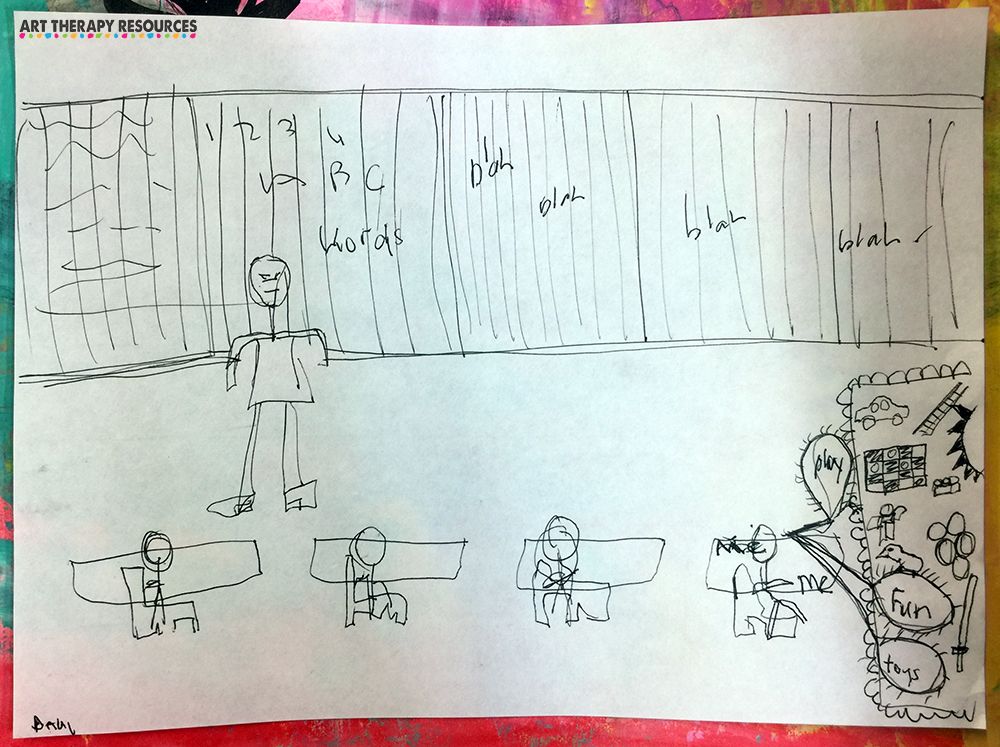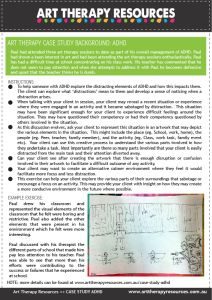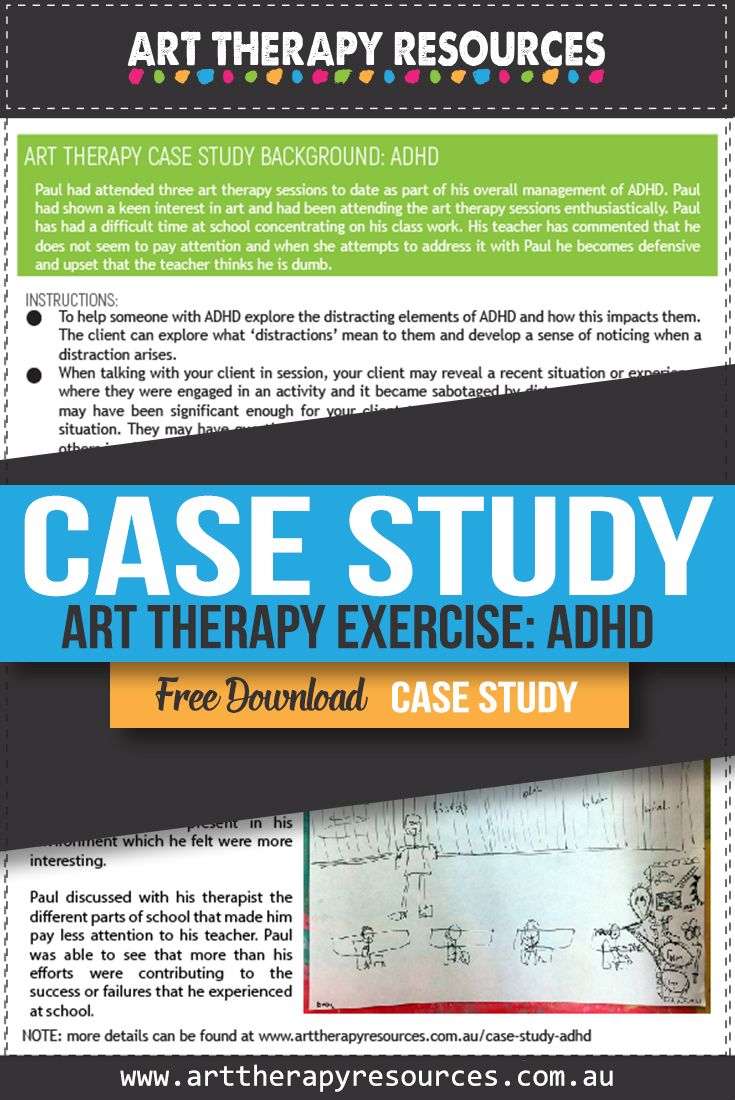THIS POST INCLUDES:
- Art Therapy and ADHD
- About the Client
- Current Client Issues
- Art Therapy Exercise
- Client Insight and Outcomes
- Disclaimer
- FREE DOWNLOAD Art Therapy Exercise
ART THERAPY AND ADHD
ADHD is a neurodevelopmental disorder that is defined by inattention, disorganization, and/or hyperactivity-impulsivity. ADHD begins in childhood, however, it often persists into adulthood with an impact on social, relationship, academic, and occupational functioning.ADHD is a neurodevelopmental disorder that is defined by inattention, disorganization, and/or hyperactivity-impulsivity. ADHD begins in childhood, however, it often persists into adulthood with an impact on social, relationship, academic, and occupational functioning.
According to the DSM-5, the diagnostic criteria for ADHD are:
A. A persistent pattern of inattention and/or hyperactivity-impulsivity that interferes with functioning or development, as characterized by (1) and/or (2):
- Inattention: Six (or more) of the symptoms have persisted for at least 6 months to a degree that is inconsistent with developmental level and that negatively impacts directly on social and academic/occupational activities
- Hyperactivity and impulsivity: Six (or more) of the symptoms have persisted for at least 6 months to a degree that is inconsistent with developmental level and that negatively impacts directly on social and academic/occupational activities
The DSM-5 contains other diagnostic criteria, however, the above specifies the primary criteria for inattention and hyperactivity and impulsivity. The DSM-5 also includes disqualifiers for behaviour that may relate to other mental disorders such as mood, anxiety, and personality disorders.
CORE ISSUES
The core symptoms of ADHD include:
- Inattention
- Lack of focus
- Time management problems
- Impulse control issues
- Hyperfocus
- Hyperactivity
- Executive dysfunction
In children, these core symptoms interfere with the child’s development and everyday functions. These symptoms can be frustrating for those with ADHD and consequently, they may have intense emotions at the obstacles and disruption that occurs in their lives.
If children are introduced to strategies and coping mechanisms to help mitigate the impact of ADHD, they can help reduce any negative impact on life outcomes in adult life.
INATTENTION
Individuals with ADHD can be impacted by inattention problems through being distracted, inability to finish projects, and difficulty in listening which can be detrimental in both professional and personal relationships.
To deal with these issues of inattention, individuals can learn strategies that will help them identify the tasks that are most likely to be problematic and introduce techniques that will help reduce distraction and maximise focus on the task.
Some strategies that people with ADHD can integrate into their external environment include:
- Listening to instrumental music to help screen out other noises
- Work in a space with limited noise distractions
- Using earbuds
- Blocking out technology that emits notifications
- Limiting visual distractions, eg. Posters, noticeboards etc
- Visual reminders to focus attention back to the task
Some strategies that people with ADHD can integrate into their internal experience include:
- Developing incentive and reward systems for achieving targets
- Using competition strategies to ‘beat’ a goal or target
- Repetitive learning of difficult tasks
- Setting goals
- Implementing cognitive rest breaks
HOW ART THERAPY CAN HELP WITH ADHD
Art therapy can help provide a unique space for people with ADHD as they gain control over their environment and the creative process in which they work. Often we are forced to adhere to schedules, rules, and timetables which require a degree of compliance to appear successful at an endeavor. This can be a difficult process for people with ADHD as they struggle to adhere to the norms of time and organization. These struggles are a continuous source of discontent as people with ADHD feel an ongoing sense of failure to meet expected norms of compliance.
Art therapy can provide a space in which people with ADHD can express their own rules around creating. Art therapy also provides a space in which an individual can express intense emotions and frustrations. Additionally, art therapy can help establish a place of calm and focus for the client.
Given the freedom of expression and lack of ‘rules’ to conform to, people with ADHD can begin to develop a sense of mastery and consequently a sense of confidence that stems from strengthened self-esteem.
Art therapy can incorporate useful activities that help clients develop an approach to problem-solving through working with art materials. Clients can also be exposed to the tangible outcomes of using different art materials in different ways and learn to adapt to any unexpected or expected results from their choices. This can invariably teach clients valuable lessons about delaying impulsivity and engaging in purposeful decision-making.
Clients can also develop the building blocks of focusing attention over time as they learn to construct art projects that may be multi-layered and developed over stages. This can all be achieved under the supportive environment of self-expression and making individual choices.
Art therapy is especially useful for children with ADHD as they struggle to express the frustrations they may have through verbal talk therapy. Using art therapy helps introduce the child to an environment that may be familiar to them for facilitating freedom from limitations.
Art therapy can also provide insight into the benefits of developing a structure that can help foster desired results. This can be explained through the process of drawing simple shapes that help clients experience the outcomes of connecting shapes together to form overall images. This can be a helpful metaphor for developing the important building blocks that are required to learning a new skill or developing a plan to complete school homework, work projects, or other external expectations that people with ADHD may need to undertake.
Clients who attend a number of art therapy sessions over time can begin to see the tangible progress of their artwork over time which can help develop long term connections as well as a sense of accomplishment.
ABOUT THE CLIENT
- Name: Paul
- Age: 11
- Summary of sessions to date: Paul had attended three art therapy sessions to date as part of his overall management of ADHD. Paul had shown a keen interest in art and had been attending the art therapy sessions enthusiastically.
CURRENT CLIENT ISSUES
Paul has had a difficult time at school concentrating on his class work. His teacher has commented that he does not seem to pay attention and when she attempts to address it with Paul he becomes defensive and upset that the teacher thinks he is dumb.
ART THERAPY EXERCISE
To help someone with ADHD explore the distracting elements of ADHD and how this impacts them. The client can explore what ‘distractions’ mean to them and develop a sense of noticing when a distraction arises.
INSTRUCTIONS:
- When talking with your client in session, your client may reveal a recent situation or experience where they were engaged in an activity and it became sabotaged by distraction. This situation may have been significant enough for your client to experience difficult feelings around the situation. They may have questioned their competency or had their competency questioned by others involved in the situation.
- As this discussion evolves, ask your client to represent this situation in an artwork that may depict the various elements in the situation. This might include the place (eg. School, work, home), the people (eg. Peer, teacher, family member), and the activity (eg. Class, work task, family event etc).
- Your client can use this creative process to understand the various parts involved in how they undertake a task.
- Most importantly are there so many parts involved that your client is easily distracted from the main task and their attention diverted away.
- Can your client see after creating the artwork that there is enough disruption or confusion involved in their artwork to facilitate a difficult outcome of any activity.
- Your client may want to create an alternative calmer environment where they feel it would facilitate more focus and less distraction.
- This exercise can help your client explore the various parts of their surroundings that sabotage or encourage a focus on an activity. This may provide your client with insight on how they may create a more conducive environment in the future where possible.
CLIENT INSIGHT AND OUTCOMES
Paul drew his classroom and represented the visual elements of the classroom that he felt were boring and restrictive. Paul also added the other elements that were present in his environment which he felt were more interesting.
Paul discussed with his therapist the different parts of school that made him pay less attention to his teacher. Paul was able to see that more than his efforts were contributing to the success or failures that he experienced at school.

DISCLAIMER
This case study represents a snapshot of the client’s progress in treatment. The exercise in this article could be used as written or as a guide for new and original tasks developed by the Art Therapist. Responsibility for treatment resides with the individual therapist who understands their client’s specific needs. The art therapy exercise should not be viewed as a pre-defined directive on how to treat a client that presents with a specific range of problems.This art therapy exercise will help build a database of knowledge to draw upon when helping your client. Art Therapy is associated with psychotherapy techniques, however each therapist often approaches therapy with their own foundation of psychological interventions, whether it be psychotherapy, CBT, DBT or other methods.
FREE DOWNLOAD: Art Therapy Exercise
Download the FREE Art Therapy Exercise based on the above Case Study. The free download includes instructions for the art therapy exercise, along with an example of the art therapy exercise.

BUILD YOUR ART THERAPY REFERENCE MATERIALS:
Pin this image to your Pinterest board.

SHARE KNOWLEDGE & PASS IT ON:
If you’ve enjoyed this post, please share it on Facebook, Twitter, Pinterest. Thank you!
